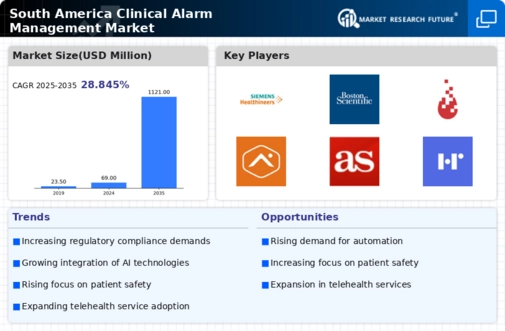Aging Population
The demographic shift towards an aging population in South America significantly influences the clinical alarm-management market. As the population ages, there is a corresponding rise in chronic diseases, necessitating continuous monitoring of patients. For example, by 2030, it is estimated that over 20% of the population in countries like Argentina and Chile will be over 60 years old. This demographic trend creates a heightened need for effective alarm systems that can alert healthcare providers to critical changes in patient conditions. Consequently, healthcare facilities are increasingly investing in advanced alarm management solutions to cater to this growing patient demographic. The clinical alarm-management market is thus poised for growth as healthcare providers adapt to the needs of an older population, ensuring timely interventions and improved patient outcomes.
Focus on Patient Safety
The growing emphasis on patient safety in South America is a crucial driver for the clinical alarm-management market. Healthcare organizations are increasingly prioritizing safety protocols to minimize risks associated with alarm fatigue and false alarms. Regulatory bodies are advocating for improved alarm management practices, which has led to the implementation of stricter guidelines. For instance, the Pan American Health Organization has been promoting initiatives aimed at enhancing patient safety across the region. This focus on safety is prompting healthcare facilities to invest in advanced alarm management systems that can effectively reduce alarm-related incidents. As a result, the clinical alarm-management market is likely to expand as healthcare providers strive to meet these safety standards and improve overall patient care.
Integration of IoT in Healthcare
The integration of Internet of Things (IoT) technology into healthcare systems is transforming the clinical alarm-management market in South America. IoT-enabled devices facilitate real-time monitoring and data collection, allowing for more effective alarm management. Hospitals are increasingly adopting these technologies to enhance patient safety and streamline operations. For instance, the market for IoT in healthcare is expected to grow at a CAGR of over 25% in the coming years. This trend indicates a strong potential for the clinical alarm-management market as healthcare providers seek to leverage IoT solutions to reduce alarm fatigue and improve response times. The ability to analyze data from multiple sources in real-time enhances decision-making processes, thereby driving the demand for advanced alarm management systems.
Increasing Healthcare Expenditure
The rising healthcare expenditure in South America is a pivotal driver for the clinical alarm-management market. Governments and private sectors are investing more in healthcare infrastructure, which includes advanced alarm systems. For instance, Brazil's healthcare spending is projected to reach approximately $200 billion by 2025, indicating a growing demand for efficient clinical alarm systems. This increase in funding allows healthcare facilities to upgrade their alarm systems, ensuring better patient monitoring and safety. As hospitals and clinics seek to enhance their operational efficiency, the clinical alarm-management market is likely to experience substantial growth. Furthermore, the emphasis on patient-centered care is pushing healthcare providers to adopt technologies that minimize alarm fatigue, thereby driving the demand for sophisticated alarm management solutions.
Rising Demand for Telehealth Services
The increasing demand for telehealth services in South America is influencing the clinical alarm-management market. As more patients seek remote healthcare solutions, the need for effective alarm management systems becomes paramount. Telehealth services often require continuous monitoring of patients, which necessitates reliable alarm systems to alert healthcare providers of any critical changes. The telehealth market in South America is projected to grow significantly, with estimates suggesting a CAGR of around 30% over the next few years. This growth indicates a strong potential for the clinical alarm-management market as healthcare providers adapt to the evolving landscape of remote patient monitoring. The integration of alarm management solutions into telehealth platforms is likely to enhance patient safety and improve healthcare delivery.


















Leave a Comment